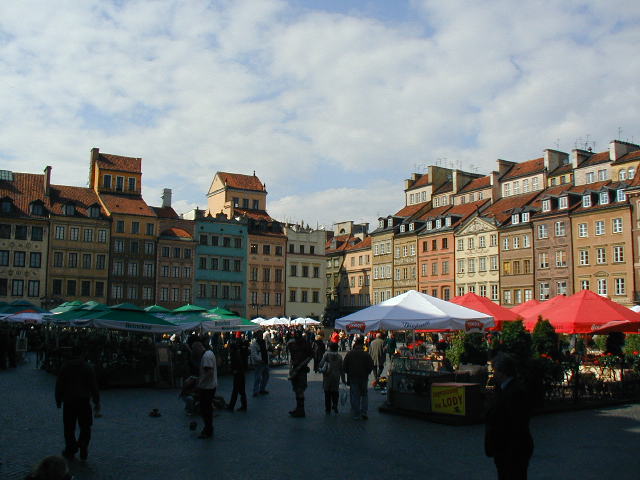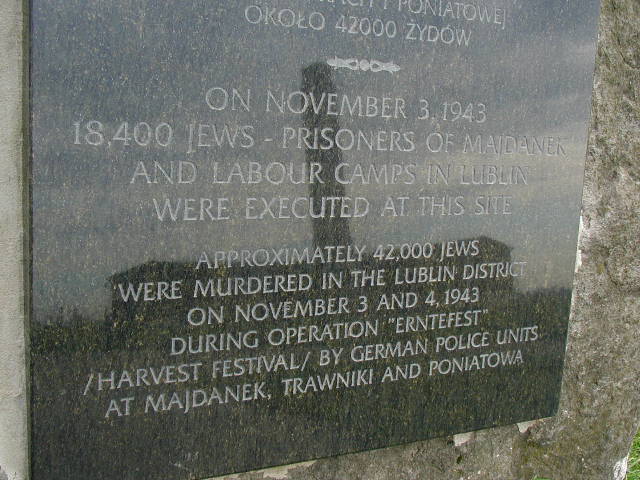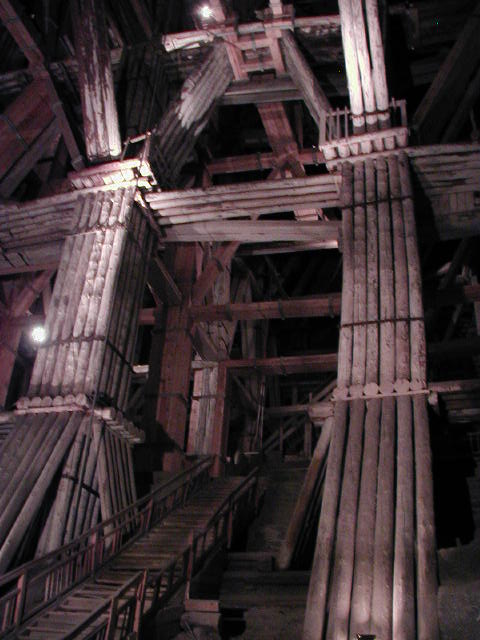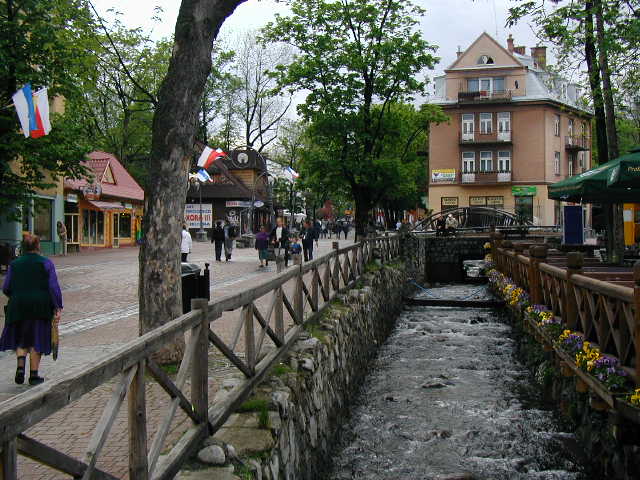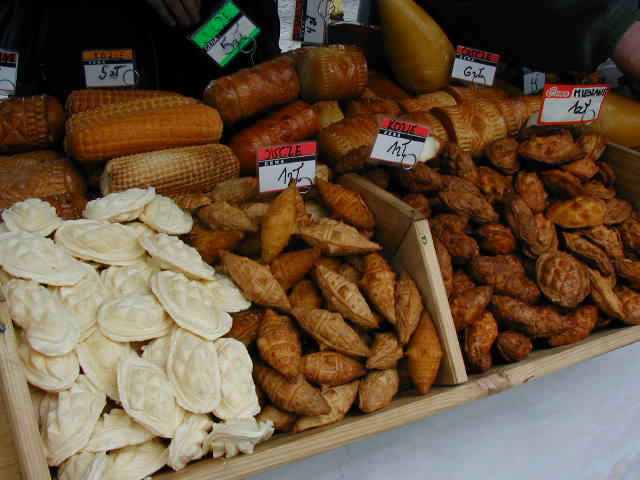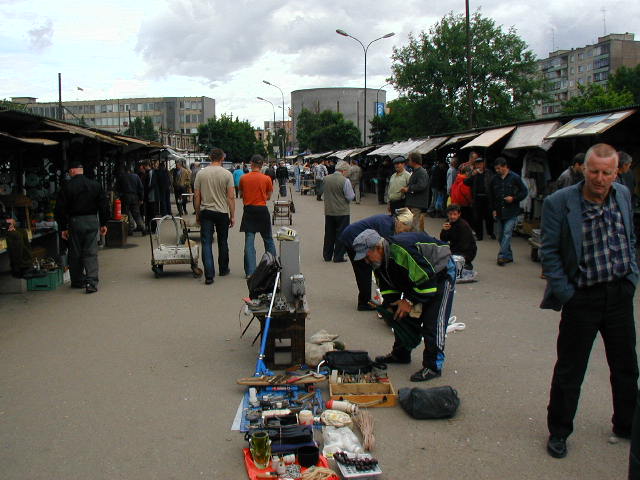|
This e-mail is the fifth mailing of 2 years worth of monthly mailings.
|
I had no intention of staying in Poland until I met Piotr in Madrid. Piotr is from Poland and in our conversations months prior, he sold me on the idea of spending at least a month exploring all Poland had to offer. Well, I didn't see it all, but I did my best in the 3 weeks I had. I arrived in Warsaw without a clue as to what to expect. This was the first Eastern European country I'd ever been to but it had also just been accepted into the European Union a few days earlier, so I wasn't sure how different it would be. The city is moderate in size, but the city center, where everything is, is very small. The streets are wider and the blocks are bigger than the ones you traditionally think of in Europe. The buildings are often spaced far apart, and it seems less dense than a city should be. Everywhere in the city center is within a few minutes walk, and even the old town is located on the edge of the center, so there is little reason to leave. I had to make a regular habit of taking the bus to the embassy district, though, so I could get my Russian and Chinese visas before I left Poland. The only other thing I couldn't find within walking distance was their brand new mall where I went for some English books, and a dose of that "American mall feel". My time in Warsaw was split up over the 3 weeks I spent in Poland as I criss-crossed between various Polish cities. Warsaw is in the middle of the country and the major transfer hub, and I had to come back several times to move my visas from one bureaucratic process on to the next. So I would spend a few days at a time exploring the city instead of getting to know it all that first visit. It isn't actually a terrific tourist city, and even it's old town only dates back to 1988. That's right, NINETEEN-eighty-eight. The second world war leveled the old town so completely that all they have left is part of an original column from the palace. It lies on its side today, riddled with shrapnel holes, outside the reconstructed palace as reminder of the destruction. So obviously it doesn't take long to see the tourist sites in Warsaw, so I spent my time exploring the livable parts of the city: the markets, shops, conveniences, theatres, parks, and of course using the public transportation. See pictures here.
Warsaw's old town, reconstructed in 1988
From Warsaw, I headed to a university town called Lublin. I had never heard of it, but university towns are always a good place for me to experience real local people while still being able to relate to them. It's also a good place to meet locals if only because young people are more likely to speak English than older generations. This was the first Polish train I'd taken and I was surprised by how nice it was. It was no ICE, but I'm no stranger to the bad rap Eastern European trains have. This was like any Spanish, or French train and was very fast as well. All my trains in Poland were like this except the local commuter trains which were pieces of junk. But every country has junk commuter trains. Lublin is at the top of a slight hill, so upon arriving at the train station, it took more than an hour of wandering and asking locals to figure out where to go. The main part of the city is centered on a pedestrian street which merges with the main road just before the three universities. The pedestrian section is lined predominantly with restaurants, but I was surprised to see there were no bars in Lublin. As it turns out, two of these universities were Catholic schools so the students weren't the typical makeup of a university town. The main street was a nice tree-lined street with the universities on one side, and sprawling parks on the other. My hostel was inside one of the parks and was well located near the universities and center of town. I spent a few days here hanging out at the universities, and walking around their old town. It's a friendly, relaxing place that doesn't see as many tourists as neighboring Krakow, so I felt more like a student than a tourist. The old town here is small and in disrepair, but is still used heavily for its housing, and small squares. See pictures here.
Also in Lublin is one of the largest, but lesser-known Nazi concentration camps, Majdanek. This was the first camp to turn into a museum, and was one of the only camps to have been abandoned by the Nazis without any damage. I hadn't been to Auschwitz yet (near Krakow), so I went to this one so I'd have a good idea, and could maybe compare it to the most famous concentration camp in history. The camp is just outside of town in a farming area. There's no fanfare at the entrance, with just a small shack manned by a casually dressed volunteer. The camp is set back from the road by several fields, and after 10 minutes walk I realized I was possibly the only person there. It felt eerie, which was probably precisely the right feeling to have approaching a place where 300,000 innocent victims of the Nazi regime were tortured and murdered. It was my first time to a concentration camp and I didn't expect the in-your-face nature of the camp-turned-museum. There were no barriers or ropes to distance the visitor from the rawness of the gas chambers, experimentation rooms, and dorm buildings. I was so close, I could touch anything and everything (not that I wanted to) including the half-a-million shoes taken from the victims. The small signs were rare, and minimal on information. Just enough to paint an awful picture, and leave the rest to the imagination. The last place I saw was the crematorium where they kept the melted chassis of a truck used to load the carcasses of gassed (and sometimes living) prisoners into bonfires when the crematorium couldn't burn bodies fast enough. On my way out of that last building, I passed by the spot of the bonfire. In its place, a monument had been built. It was a huge cement bowl 15 meters in diameter with an identical bowl hovering inverted 1 meter above it. Inside was the most disturbing evidence of human genocide I have ever seen. The 15 meter wide, 5 meter deep bowl was filled with a 6 meter high pile of human ash with an occasional vertebrate, or femur poking through. I couldn't even identify it as such, and even wondered who would have thrown bones on this strange pile of gray dirt. The truth was an impossibility in my mind until I read the proof on a placard. Needless to say, the Majdanek concentration camp museum was a powerful experience.
Crematorium silhouette at the Majdanek concentration camp
The next day I headed to Krakow, where I would sleep that night, but was eager to see Auschwitz, so without even leaving the Krakow train station, I got on a local train to the famous Auschwitz concentration camp 60 kilometers outside the city. The museum includes both Auschwitz and Birkenau (which is commonly called Auschwitz II) camps. I joined a tour which seemed unnecessary once I entered the camp and realized it was a much more descriptive museum than Majdanek. Signs were thorough, and everywhere. It was more or less a similar story to Majdanek but with more distance between the viewer and the exhibits. Glass windows allowed me to look in rooms filled with hair, or spectacles collected from prisoners, and it was moving, but also more impersonal than Majdanek. I felt rushed by the tour and thought it was a mistake to take it until we left Auschwitz and arrived at Birkenau where we were all in for a surprise. We had just entered the larger, newer Birkenau camp, where most of the prisoners were held and exterminated towards the end of the war, when all of a sudden a tour group member couldn't contain herself any longer. She stood up in front of the group and asked if she could tell us her story. Birkenau was actually the largest of 3 camps known (as a conglomerate) as Auschwitz. This largest camp is where all the Hollywood films go because it's got the famous train tracks built right into the camp (to make extermination more efficient). Well, this largest camp is also where this old woman was held as a child prisoner in 1944. I actually couldn't believe it at first. I immediately went into that "city mode" we all go into when someone crazy starts yelling on your subway car. I literally thought she was a crazy woman who thought she was there. Meanwhile she was starting to choke on her words, and cry uncontrollably. The last bit she sort of made out was that she couldn't even tell her son. Now, take your guard down, and tell me what would you do? I mean, the woman was actually at Auschwitz, and is now a frail old woman coming to terms with the reality... 60 YEARS LATER!! Well, the tour guide hugged her, but I took a step backwards. I felt really weird, like maybe I never really grasped this reality any more than a Hollywood movie. The tour guide walked off, then, and started to cry. She saw this every week. I felt really awful after all was said and done, for not actually believing her. Not that she knew, but what does it say about me? Am I ignorant, or just jaded? Did I really think this happened so long ago that there couldn't be any REAL people still alive? Under normal circumstances I wouldn't have hugged a stranger, but now, I feel like the fact that no one in the group hugged her, or even really wanted to look at her (myself included) was subtly a pretty mean and Nazi-sympathetic thing to do to this woman. I'm no Nazi, but I started wondering if I were in Germany in a different time, if I would be one of those who just turned their head. Backing away from atrocities just because they didn't directly affect me. Group Psychology. Well, that's just a little tiny bit of 2 days of Nazi (and don't forget, Soviet!) concentration camps which included loads of memorable, thought provoking experiences. See pictures here.
Later that same day I went back to Krakow and went out with a girl I met on the tour. One of her friends was a local guy from Krakow so we saw some of the best places in the Jewish quarter with interesting themes and decor like Singer sewing tables complete with sewing machines in the middle, and a suspended seating area we had to climb a ladder to sit in. At midnight I felt I ought to find a place to stay for the night so I stumbled through the Jewish district to Nathan's Hostel. I stayed a few days to explore the squares and back alleys of the rambling town, and even got the chance to make a day trip out to some salt mines 40 minutes from town. The city has got to be one of the top 10 cutest European cities, which is at least partly owed to the fact that it was completely ignored during the bombing raids of the war. While Warsaw had to completely rebuild from scratch, Krakow's walled old town didn't lose a single building. And while the tourists were noticeable, I think Krakow doesn't see as many tourists as its nearby neighbor, Prague, which has become very popular for young tourists. That was great since the main square was already almost full of local youths anyway. Any more tourists, and the cute city would have become oppressively congested. See pictures here.
Some of the people I met at Nathan's knew how to get to the salt mines which Piotr had recommended months earlier as a highlight in Poland, so we all went together. These salt mines were no longer being used, and had been turned into a museum of sorts. It was a guided tour that started with a long walk 500 meters straight down a miner's staircase. At the bottom the temperature was a cool 12 degrees with a subtle but decidedly clean dampness in the air. The air was so clean, in fact, that there was a spa in the mine where celebrities where reputed to go to breath the air for week-long retreats. We were told that there were 200 kilometers of tunnels dug in this mine, and not to stray from the group as people have died after getting lost in the labyrinth of tunnels, rooms, and halls. The tour itself wasn't as interesting or memorable as the tunnels we walked through which stretched infinitely into the darkness to the left and right of the tour route. I knew the mystery and solitude of these miner's lives could never be known to those outside the brotherhood, but being there in their world made the imagination race. The miners would spend a minimum of 2 months at a time down in these tunnels and so various conveniences such as churches and restaurants were built down there. In each of these, salt was the widely used building material and aesthetic addition. It was used creatively as glass for candle chandeliers, and translucent material for religious sculptures. Seeing their great assembly hall with 6 ornate chandeliers made entirely of salt, while walking down the grand staircase made entirely of smooth, moist salt rock, was one of the highlights of the walk. In the end of the tour we crammed into a double-decker mining elevator 12 at a time even though it was only a meter long, and less than a meter wide. As soon as the triple doors slammed shut, we were catapulted up 500 meters to the surface with what seemed like unnecessary acceleration. The shouting from elevators every time they went up sounded like an amusement park ride no one expected. See pictures here.
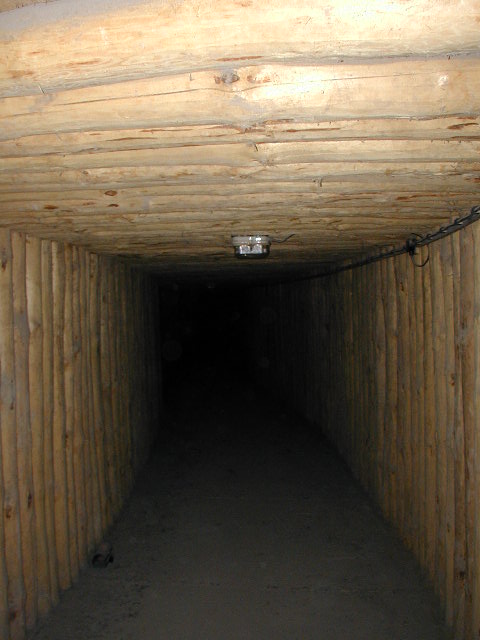 The tunnels of the salt mines stretch into the darkness for 200km |
|
After 4 days in Krakow, including 1 day at Auschwitz, and 1 at the salt mines, I headed down to the southern border of Poland, to the ski town of Zakopane. Zakopane is in the Carpathian mountains on the border with Slovakia, and has put their bid in for the next available winter Olympics. The town is unlike other parts of Poland I'd been to, and almost resembled Aspen, or some upscale contrived ski resort. It was off-season for the ski town so I was able to stay at a virtually empty, rambling hotel right out of The Shining. Still, I was staying in their dorm room, but aside from being really nice, and cozy, I ran into some guys I'd met before in Poland. They'd just tried climbing one of the mountains, but the snow was still too deep on the trails. They were cold and wet so we decided what better cure than beer! The liquor store, like all corner shops in Poland, was entirely behind a counter. Whether it's a book shop, a food market, or a liquor store, Polish shops all require that you point to an item, and the clerk retrieve it for you. This can prove difficult when you can't speak the language. Especially when you'd like advice on if this is sweet, or that is pre-cook, etc. I usually ended up with something I had never seen before, and could be a condiment for all I knew. This time it was simply a problem of figuring out the prices on the unmarked beers. After holding up a long line, I finally went with 10 of the popular Polish beers, which was good enough for everyone back at the dorm. The beers were quickly finished, and we went out to explore the nightlife. There wasn't much, but we found a darkened courtyard behind a restaurant to eat our take-away pizza in. As it turned out, the restaurant was putting on a traditional dance performance, so we got a free show easily seen through the large windows looking out onto the courtyard.
Pedestrian street in Zakopane
The next day I had to leave so I could get to the Russian embassy, but before the afternoon bus, I was able to wander around some different areas of town. It was market day, and I headed down to market and the base lodge at the ski resort. Both were full of people. The lodge had a long line of local kids waiting to go up the chair lift for a view from the top of the Carpathians, and the market was full of wives and mothers shopping for their daily cheese and breads. The cheese in Poland is unidentifiable as such. I had been seeing it being sold by street stalls since my first day in Warsaw but was sure it was a pastry of some sort. Cheese comes in small spear-shaped shiny pieces, each stamped with ornate patterns and local designs. It looks like an ornate pastry with an egg white shine. When I went to try one at the market I was surprised to find it to be a mild goats milk cheese instead. See pictures here.
Polish cheese!
After the market I caught my bus to Krakow where I transferred to a train to Warsaw. My experience at the Russian embassy was difficult going from the very first day. Before I had gone to Lublin, Krakow, and Zakopane, I visited the Russian embassy in Warsaw with all the paperwork, photos, and passport Xerox's I thought I needed. The opening time was 9AM, so I arrived at 8:30 the first day. By 8:30 there was already a line of about 20 people. We all waited outside and were let in one-by-one as the muffled speaker box shouted in Russian. After three hours it began to rain. Only 15 people had gone inside. Mysteriously, each person who went inside would come out after 20 minutes, walk off, and return 15 minutes later and cut the line to go back inside. At 12:30 I was next in line and ready for the speaker box to shout something. Nothing had happened for almost an hour, and there was a line behind me of 30 people. It had been raining for an hour. The woman behind me asked me something in Russian, and then pressed the button on the speaker box. The box shouted back, and everyone in line groaned. I asked what was going on, and someone told me they had closed for the day half an hour ago. Good of them to tell us. On my second day I arrived at 7:30 and was 3rd in line. I was inside 2 hours later. Though I had brought a visa application form from the Russian embassy website, they said it was the wrong one, but were good enough to let me fill it out at the counter. I had to lie a little about my employment status, membership in "any organization whatsoever", and previous travel experience to avoid suspicion.
That was a week earlier. This time I just had to come pick up my visa. The afternoon line was relatively fast moving because there was no visa processing, just pickups. Still, they didn't make it easy. I learned why people had been leaving only to return 15 minutes later when I went to pay for the visa. Instead of taking money themselves, they gave me a pink deposit slip. I had to walk down the street to a bank and deposit the visa fee directly into the embassy bank account. The bank gave me a different receipt and I had to show the embassy the receipt to prove I'd paid before they would give me my passport back with the new visa inside. ...And people say Russia is bureaucratic...
That same day I had hoped I could start the Chinese visa process, but they were only open 2 days per week, so I had to wait a few days to start the whole process over with the Chinese embassy. I decided to take a 2 day trip up to the north and see Gdnyia and the north coast. I made it up to Gdnyia first. I expected it to be a sea side resort town of a sort as I had been told. I checked with an info desk in the train station to find accommodations, but the woman said everything was booked solid. She called some places for me, but all were full. I decided to figure things out on my own and head into town. Once I figured out how to get from the train station into town I started looking for a cheap hotel that might not register with the tourist info office. Every hotel I went to was full. I even went to some upscale hotels thinking I'd bite my tongue, and pay the extra amount for just one night. But even the upscale hotels were booked solid. After offering to sleep on the floor of the servant's quarters, one of the hotels told me about a place they were sure would have room. I headed to the recommended hotel, and though the whole walk was along the beach, I was starting to get fed up. It was cold. No one had been friendly with me (except 2 schoolboys who walked me a good kilometer to a hotel), and this supposed beach resort town was a has-been. At the end of the beach was the hotel. For some reason it was empty despite the beachfront location. I was happy to check into the cramped single room they offered and go out for a walk through town.
The town seemed like an defunct resort town that was settling in to more of a working class disposition. There were a few out of place fashion stores, and a number of restaurants, but the majority of shops seemed to be pawn shops and dusty bodegas. The place wasn't for me, so I found a nice restaurant and chalked this stop up to outdated advice. I had hoped to go to a small town called Leba which Piotr had recommended as a peaceful place with beautiful sand dunes, but upon looking into the bus schedule to get there and back I realized I'd be stuck there on the days I should be processing my Chinese visa. I had read about Gdansk as the most dangerous place in Poland to take a train. Many gassings and even violent robberies had taken place around Gdansk and at least one person had said it was a dirty city. I didn't really think this sounded appealing, but I only had one day to spare before heading back to Warsaw to process my visa, and Gdansk was the only destination I could go to with exception of staying in Gdnyia another night. So I made a pit stop in a small town called Sopot to see "the best beaches in Poland" and continued to Gdansk. I had no problems on the trains, and the city was anything but the dirty bustling city it had been made out to be. To the contrary, it was an adorable Scandinavian influenced town with a quaint port. I wish I had given Gdnyia a miss and spent 2 days here, but such is luck and timing. I spent the whole day relaxing at the docks that looked back on the cute waterfront buildings. The city does have a new street trolley network and a modern shopping plaza near the grand train station, so it's not all old world charm, but even that area is clean and full of young people and energy. The hostel I stayed at was lacking in charm, but was big, and clean. See pictures here.
Scandinavian architecture in Gdansk
When I got to the Chinese embassy in Warsaw the next day I felt like an embassy pro, and showed up at exactly the right time. All my paperwork was in order this time, but there was still a catch. Apparently the Chinese embassy only accepts applications from citizens and nationals, so technically I would have to go to the Chinese embassy in my own country to get a visa. I had to speak with the consulate and prove I was traveling around the world, and could not feasibly apply for visas ahead of time. Most countries will only issue visas for a period within 6 months of entering the country. The consulate gave exception to the rule for me, and miraculously the process was accelerated to have a visa ready for me the very next day. That same day I made it to the local hospital and got my Yellow Fever vaccination, as well as made a visit to a western doctor who prescribed the malaria medication I'd need in India and south east Asia. Unfortunately, I needed the signature of the Ministry of Health for any pharmacy to give away such strong medicine, and the next day when I went, the MOH was closed. Having picked up my Chinese visa by then, I had made my plans to leave Poland, so I never got a signature for the Mefloquine. I suspected I could get the drug without a prescription in Asia anyway, so I left early the next morning for Vilnius, Lithuania.
The ride to Vilnius was through the beautiful north eastern fields of Poland which I was glad to get to see since I didn't have time to travel up there during the 3 weeks I had in Poland. The land is lush and green, and though relatively flat, filled with unspoiled beauty I hadn't seen since Switzerland. The only hiccup was a connection at the border. I was traveling with a girl I had met at Nathan's affiliate hostel in Warsaw (the best hostel I'd stayed in in Poland). We ran into an odd American in search of a place to live abroad, though he couldn't seem to see any positive sides to the countries he'd been to. At the transfer station we had all forgotten about the time difference between Poland and the Baltics. We thought we had an hour before the connecting train, so he wandered off. As soon as he was gone, the connecting train showed up and everyone boarded. The station was in the middle of a field with no sign of a town nearby, so the American was left behind until the next day's train. No doubt it turned into another of his stories about how backward foreign countries are.
The landscape in north eastern Poland
I didn't know what to expect in Lithuania. As we sped through the fields and villages on our way to Vilnius all we saw was a lack in graffiti we had gotten used to in Poland. In fact all the stations we passed had nice new paint jobs. When we arrived in Vilnius we were scooted around hostels by the owners in their Russian cars until we found one that had room. I didn't think I'd spend much time in the town from the looks of it, so I went to explore with a British hosteller I met. We made it to the old town which was filled with churches and other religious monuments, and settled for a dinner at a recommended traditional Lithuanian restaurant. Traditional Lithuanian food includes potato dishes, and various soups (most of which look and taste the same - bland, starchy, thick white broths with tasteless potatoes). The next day we made it to all the points of interest either of us were interested in. The city hall, with its road blocks and barbed wire left over from the student revolt against the Russian army. The only statue of Frank Zappa in the world. More of the old town, and a Russian orthodox church mentioned in a guidebook. And the piece de la resistance, the farmers market. We spent most of our time that second day in the farmers market, which was unlike any we'd ever seen. Remarkably, we couldn't find anything to eat except some pickles, and what seemed like Lithuanian honey. What was great about the market was that it wasn't selling anything anyone would want. Many stalls were set up in a plastic mat on the ground which was covered by used and broken junk from someone's attic. Some of the more "useful" stalls had chicks or puppies for sale. The most market-like area was in a series of airplane hangers. Each hanger specialized in it's own thing, with one hanger devoted exclusively to bacon. In the bacon hanger people were trying the uncooked, unrefrigerated bacon before buying to determine if it was good enough to serve their family. It was a truly Eastern European market experience. See pictures here.
The farmers market that sold nothing but broken junk
Ultimately, Vilnius was not worth staying in beyond that second day, so I made my way to Riga, Latvia. I had limited time before I had to be in Russia (the Russian visa is very precise about it's dates of entry and exit), so I had to decide carefully on how much time to spend in the Baltic's. With only 1 week for all 3 countries, I knew I didn't have time for anything except the capitols, which won't ever give a true feel for the culture, but I could either see all 3 countries, or spend the entire week in one, so I chose to see Vilnius, Riga, and Tallinn. Vilnius was sort of a depressing place, and I hoped Riga would prove more exciting. I was rewarded with a full-on city complete with old town, parks, modern shopping, and even a Russian neighborhood. I stayed 3 days this time, but wished I had more time. The old town was a little bigger and definitely better than the Vilnius one. It included funky cafes, and relaxing shopping, including a department store in an old 4 level building. The weather was bad most of the 3 days I was there, but that didn't detract from the feel of the city. To the contrary, it added to the strong Russian feel of the place. The neighborhoods branching out from the old town were Soviet style blocks, but the locals on the streets below were a trendy European crowd. I got pretty far away from the center of town to see the local life. It exemplified the up-and-coming nature of the Eastern European states to a tee. Though they didn't have modern buildings or as much money to work with, the living standards of the locals seemed to be far above those you'd imagine to live in these Soviet flats. Expensive cafes, mini fashion boutiques, and expensive car dealerships occupied the lower levels of the once poverty-stricken neighborhoods. After 3 days of lounging in parks, wandering Soviet streets, and reading in the old town cafes, I had to push on to Tallinn, hoping it would live up to its reputation as the "Paris of Eastern Europe". See pictures here.
Boy did it live up to that reputation!! Tallinn's old town is the center attraction to the city. Outside old town, it quickly peters off into empty modern business districts, and then boring main roads and shipping docks. But inside the old town is filled with charming old crooked Scandinavian buildings and traditionally dressed girls selling simple goods like home made candies (boiled and poured in front of you). And though the daytime offers nice walking, and friendly locals to talk to, it's the fashionable nightlife that it's drawing attention for. As soon as the sun goes down the streets fill with the young and trendy. The city, though small, is attracting the attention of all of Europe as one of the newest clubbing cities in the continent. The British, Swedes, Finnish, Swiss, and Germans are flocking to the city as an alternative cheap clubbing weekend destination. I was staying in a hostel beneath a strip club, and across the street from 4 clubs and bars, so there was no way I was going to miss out on the nightlife. My first nights I hung out with 2 sailors (Katie and Neil) who had spent a few years sailing around the world on a 100 year old three-mast ship. Their stories of living on a ship were fascinating and a great backdrop to this old shipping city. When they left I continued clubbing with a Swiss guy who had come up for a week of debauchery. We met up with 3 Germans who were intent on avoiding sleep for their entire stay. I woke up the next morning at 5AM to get to the bus station to figure out how to get to Russia. On my way out I ran into the red-eyed Germans who had just come back from Club Hollywood and were also heading to the bus station. We piled into a taxi with an added surprise. In true Eastern European fashion, the taxi had a DVD player in the front playing Russian porn. The bags could barely fit in the trunk with all the stereo amplifiers and subwoofers, so we arrived at the bus station blaring moans and wet slaps. It was too perfect a send-off from this hedonistic city. See pictures here.
Next, I'll be spending 2 weeks in St. Petersburg and Moscow before heading to China via the Trans Siberian Express on a week long journey across 9,000 km and 8 time zones. Hope I survive Russia!
Take care at home, and on your travels,
Christian
